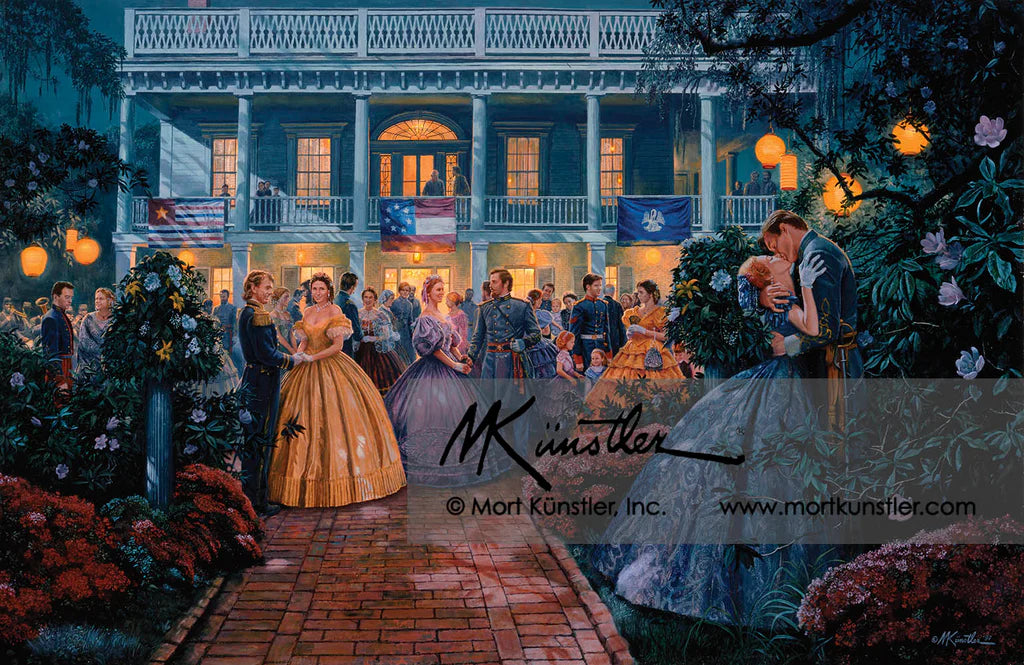Künstler
Moonlight & Magnolias
Moonlight & Magnolias
Couldn't load pickup availability
This is Mort Künstler limited edition print - Moonlight & Magnolias. Arlington Plantation, Lake Providence, Louisiana, April 6, 1861.
Image Size: 18” x 29-1/2” • Overall Size: 22-1/2” x 33-1/2”
Signed Museum Edition • Edition Size: 250.
Mort Künstler’s Comments
A stolen kiss! A farewell and a proposal of marriage at the Secession Ball when the world and the Confederacy were young! These were the ideas that flashed through my head when I first saw Arlington Plantation on Lake Providence in the northeastern corner of Louisiana.
I was contacted by Sam Wyly, who along with his daughter, Kelly, came to my studio to ask if I would be interested in creating a Civil War painting incorporating his ancestral home, Arlington Plantation. After seeing photographs of the house, I realized this was a perfect Southern mansion from the antebellum era. I immediately saw the possibilities for an unusual painting.
I traveled to Lake Providence to explore the building and learn as much about the area as was possible. Arlington Plantation was originally built as a single-story house in 1832 for Mrs. T.R. Patten. It was later raised and made into a two-story manor house by Edward Sparrow, Chairman of the Committee on Military Affairs for the Confederacy, who voted for secession in Baton Rouge on January 26, 1861. The house is now occupied by Steve and Flo Guenard, direct descendants of Sparrow, who have maintained it in beautiful condition and are continuing a very successful program of restoration. They were most gracious hosts and knew much of the history of the building. To this day, Sparrow Road in Providence leads to Arlington Plantation.
On Saturday, April 6, a grand ball was held at Arlington Plantation and people from as far as Baton Rouge and New Orleans attended. Here was my idea! What a great way to use the warm glow of the lights and Japanese lanterns so popular in that era to contrast the cool moonlight outside. The center flag hanging from the upstairs porch rail is The First National Flag of the Confederacy. On the right is the Pelican Flag of Louisiana before secession. On the left is the Louisiana state flag adopted on February 11, 1861. It had thirteen stripes but alternated the colors of blue, white and red, to reflect its original ties to France. The canton of the flag had a large single yellow star on a field of red to show its early origins with Spain.
At this time, Louisiana troops were among the best equipped and uniformed in the Confederacy. There was still no standardization and there were as many blue coated Confederates in Louisiana as grey clad ones. Some regiments had as many as ten different uniforms. Here existed the rare chance to depict a bit of antebellum life and show the different types of uniforms that caused so much confusion in the early months of the war.
On the extreme left, a 1st Lieutenant of Louisiana Zouaves chats with his wife. At this point, the war had not yet begun and in everyone's mind was a quick victory and a new nation – all glory and honor. The realities and horror of the war would follow.
The next couple, to the right of the flower arrangement resting on the column, shows a former U.S. Naval Commander in full dress uniform. He has resigned his commission and awaits assignment to the Louisiana or Confederate Navy. He and his wife in the golden dress are the only ones at the party that spot the stolen kiss and smile knowingly. In the center, with the woman in the violet dress, is a 1st Lieutenant of the C.S. Marines, a corps that received little recognition during the war. Further to the right we see a sergeant of the Washington Artillery, from New Orleans, chatting with his wife and their three children. The situation gave me a rare chance to depict a bit of antebellum life with an excellent opportunity to show all the different types of uniforms that caused so much confusion in the early months of the war.
The lighting effects and the beautifully dressed men and women make for a sparkling array of glamour and pageantry. That would all change as the war would grind on to its inevitable conclusion of destruction and grief. Two years later, Grant would come down the Mississippi and spend more than two months trying to cut a canal from the river to Lake Providence, and gain access to the Red River. This would have allowed the Union army to re-enter the Mississippi River south of Vicksburg. Union officers who would use Arlington Plantation as their headquarters included Macpherson, McMillan and MacArthur. Grant would visit the house as well.
Needless to say, life at Arlington Plantation would never be the same.
Share


Continue Shopping
See more of the Breagans' collection of manufacturers from all around the world
Subscribe to our emails
Subscribe to our mailing list for insider news, product launches, and more.

